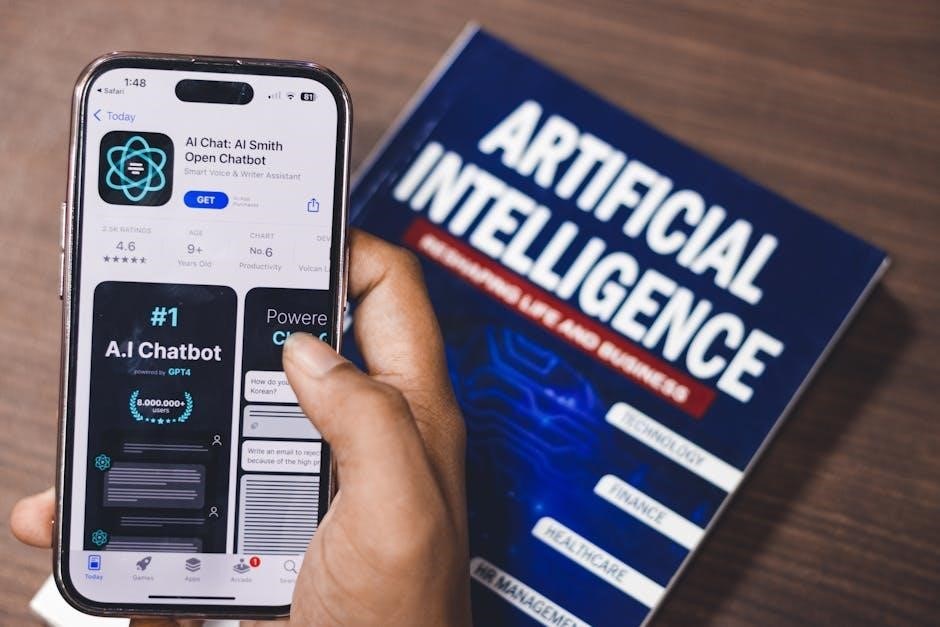Discover the essentials of machine learning and deep learning with PyTorch and Scikit-Learn․ This comprehensive guide, part of the bestselling Python Machine Learning series, offers a hands-on approach to building models, from traditional algorithms to cutting-edge neural networks․ Written by experts like Sebastian Raschka, Yuxi Liu, and Vahid Mirjalili, it provides clear explanations and practical examples, making it ideal for both beginners and experienced practitioners․ The book includes a free PDF version, ensuring accessibility for all learners․ Explore frameworks, techniques, and real-world applications, with a focus on PyTorch’s intuitive framework and Scikit-Learn’s robust tools․ Whether you’re starting your ML journey or advancing your skills, this resource is a valuable companion for understanding and implementing machine learning effectively․
Overview of Machine Learning and Deep Learning
Machine learning focuses on enabling systems to learn from data, improving performance on tasks without explicit programming․ Deep learning, a subset of machine learning, leverages neural networks to model complex patterns․ PyTorch and Scikit-Learn are essential tools: Scikit-Learn excels at traditional machine learning tasks like classification and regression, while PyTorch powers deep learning applications with dynamic computation graphs․ Together, they provide a robust framework for building and deploying models․ This overview highlights their complementary strengths, from handling tabular data to training neural networks, making them indispensable for modern machine learning workflows․ Both libraries are widely adopted in academia and industry, driving innovation and practical applications across domains․
Importance of PyTorch and Scikit-Learn in Machine Learning
Importance of PyTorch and Scikit-Learn in Machine Learning
PyTorch and Scikit-Learn are cornerstone libraries in machine learning, each excelling in distinct domains․ PyTorch, with its dynamic computation graph, is ideal for deep learning, enabling flexible and rapid prototyping, making it a favorite among researchers․ Scikit-Learn, on the other hand, provides robust tools for traditional machine learning tasks, offering a wide range of algorithms for classification, regression, and clustering․ Together, they bridge the gap between shallow and deep learning, providing a comprehensive toolkit for data scientists․ Their open-source nature, active community support, and continuous updates ensure they remain indispensable tools for developing and deploying machine learning models efficiently across various applications․
Key Features of the Book “Machine Learning with PyTorch and Scikit-Learn”
Machine Learning with PyTorch and Scikit-Learn is a comprehensive guide that bridges traditional machine learning and deep learning․ It includes a free PDF eBook with purchase, offering accessibility and convenience․ The book begins with foundational concepts using Scikit-Learn before progressing to advanced deep learning techniques with PyTorch․ Key features include practical examples, step-by-step explanations, and real-world applications․ It covers essential topics like model evaluation, hyperparameter tuning, and ensemble learning, while also exploring cutting-edge areas such as transformers and generative models․ Written by experts Sebastian Raschka, Yuxi Liu, and Vahid Mirjalili, this book is designed for both beginners and experienced practitioners, providing a structured learning path and serving as a valuable reference for ongoing projects․

Foundations of Machine Learning
Master the core concepts of machine learning, including data preparation, model training, and evaluation․ Build a strong foundation in PyTorch and Scikit-Learn for practical applications and deeper learning․
PyTorch stands out as a powerful yet intuitive deep learning framework, celebrated for its simplicity and flexibility․ Designed with a Pythonic approach, PyTorch offers dynamic computation graphs, making it easier to debug and experiment compared to static frameworks like TensorFlow․ Its modular structure allows developers to build neural networks layer by layer, aligning with how they naturally think about model architecture․ PyTorch also supports GPU acceleration, enabling efficient training of complex models․ Additionally, its extensive community and robust ecosystem provide numerous pre-built functions and libraries, reducing the time from concept to implementation; This accessibility makes PyTorch a preferred choice for both researchers and practitioners in the field of deep learning․
Understanding Scikit-Learn for Traditional Machine Learning Tasks
Scikit-Learn is a widely-used, open-source library for traditional machine learning tasks, providing efficient tools for classification, regression, clustering, and more․ It is particularly adept at handling tabular data, offering a user-friendly API for tasks like data preprocessing, feature selection, and model evaluation․ Scikit-Learn’s strength lies in its simplicity and accessibility, making it an excellent starting point for newcomers to machine learning․ The library is compatible with PyTorch, allowing seamless integration for tasks that require both traditional and deep learning approaches․ With its robust implementation of algorithms and extensive documentation, Scikit-Learn remains a cornerstone for building and deploying machine learning models effectively․
Building Good Training Datasets
Building good training datasets is a cornerstone of successful machine learning․ High-quality, representative data ensures models generalize well and perform optimally․ Techniques like data preprocessing, feature engineering, and handling imbalanced datasets are essential․ Scikit-Learn provides tools for data splitting, normalization, and feature scaling, while PyTorch integrates seamlessly for advanced preprocessing․ Ensuring diversity and relevance in data minimizes bias and improves model reliability․ Regularly auditing and updating datasets adapts models to changing conditions, maintaining performance over time․ Best practices include data augmentation and stratified sampling to enhance dataset quality and representativeness, ultimately laying a strong foundation for robust machine learning models․
Data Preprocessing Techniques
Data preprocessing is a critical step in machine learning, ensuring datasets are prepared for effective model training․ Techniques include normalization, feature scaling, and encoding categorical variables․ Scikit-Learn offers tools like StandardScaler and OneHotEncoder for these tasks․ Handling missing data through imputation or removal is also essential․ PyTorch integrates seamlessly with these processes, supporting tensor operations for efficient data manipulation․ Techniques like data augmentation and feature engineering further enhance dataset quality․ Proper preprocessing ensures models learn relevant patterns and generalize well, avoiding biases and improving performance․ By applying these methods, practitioners can transform raw data into a format optimized for training robust machine learning models․
Compressing Data via Dimensionality Reduction
Dimensionality reduction techniques simplify complex datasets, enhancing model performance and interpretability․ Scikit-Learn provides methods like PCA (Principal Component Analysis) and t-SNE (t-Distributed Stochastic Neighbor Embedding) to reduce data dimensions while preserving key information․ PyTorch supports these processes with tensor-based computations, enabling efficient implementation․ Reducing dimensions mitigates the curse of dimensionality and improves data visualization․ Techniques like UMAP (Uniform Manifold Approximation and Projection) are also explored for non-linear dimension reduction․ These methods are crucial for handling high-dimensional data, making models more efficient and reducing computational costs․ By applying dimensionality reduction, practitioners can create more manageable datasets, improving both model training and deployment outcomes․

Practical Applications of Machine Learning
Explore real-world applications like sentiment analysis, image classification, and NLP tasks․ PyTorch and Scikit-Learn enable building models for tasks such as text processing and computer vision, delivering practical solutions․
Learning Best Practices for Model Evaluation

Evaluating machine learning models effectively is crucial for ensuring their performance and reliability․ This section covers best practices such as using cross-validation techniques to assess model generalization and avoiding overfitting․ By leveraging Scikit-Learn’s robust tools for metrics calculation and PyTorch’s dynamic computation graph for iterative testing, you can systematically evaluate and refine your models․ Key concepts include understanding validation datasets, hyperparameter tuning, and interpreting performance metrics like accuracy, precision, and recall․ The book emphasizes the importance of rigorous evaluation protocols to guide model selection and optimization, ensuring that your machine learning solutions are both accurate and reliable for real-world applications․
Hyperparameter Tuning for Optimal Performance
Hyperparameter tuning is essential for maximizing the performance of machine learning models․ Techniques like grid search, random search, and Bayesian optimization help identify the best parameters for your models․ PyTorch and Scikit-Learn provide robust tools to streamline this process․ PyTorch’s dynamic computation graph allows for efficient experimentation, while Scikit-Learn’s GridSearchCV simplifies hyperparameter optimization for traditional ML models․ By systematically tuning parameters such as learning rates, regularization strengths, and network architectures, you can significantly enhance model accuracy and efficiency․ This section guides you through practical strategies for hyperparameter tuning, ensuring your models achieve optimal results for real-world applications․
Combining Different Models for Ensemble Learning
Ensemble learning combines multiple models to improve performance and robustness․ Techniques like bagging, boosting, and stacking leverage diverse predictions to reduce errors․ PyTorch and Scikit-Learn provide tools to implement these methods effectively․ Scikit-Learn offers modules like BaggingClassifier and AdaBoost for traditional models, while PyTorch enables custom ensembles, such as model averaging or stacking․ By integrating predictions from neural networks and traditional models, ensembles often achieve superior accuracy․ This approach also mitigates overfitting by averaging out individual model biases․ Practical examples demonstrate how to build and optimize ensembles, enhancing reliability and generalization in real-world applications․ This section explores strategies for creating powerful ensemble systems using PyTorch and Scikit-Learn․
Applying Machine Learning to Sentiment Analysis
Sentiment analysis involves determining the emotional tone of text, such as positive, negative, or neutral․ Machine learning models, including those built with PyTorch and Scikit-Learn, are well-suited for this task․ PyTorch excels in natural language processing, enabling the creation of recurrent neural networks (RNNs) or transformers for text classification․ Scikit-Learn provides tools like TF-IDF for feature extraction and logistic regression for training models․ By combining these libraries, developers can build robust pipelines to analyze sentiment in reviews, tweets, or other text data․ Practical examples demonstrate how to preprocess text, train models, and evaluate performance, making sentiment analysis accessible and effective for real-world applications․

Deep Learning with PyTorch
PyTorch simplifies deep learning with its dynamic computation graph and GPU acceleration․ Its modular design and intuitive API make building and training neural networks straightforward and efficient․
Parallelizing Neural Network Training with PyTorch
PyTorch offers robust tools for parallelizing neural network training, enabling efficient scaling across multiple GPUs and machines․ Using Distributed Data Parallel (DDP), PyTorch allows data to be split across devices, accelerating training while maintaining accuracy․ This approach is particularly useful for large datasets and complex models․ PyTorch Lightning, a high-level wrapper, simplifies distributed training by handling parallelism automatically․ Additionally, PyTorch supports model parallelism for large models that exceed single-GPU memory․ By leveraging these features, developers can significantly reduce training time and improve model performance․ Parallelization in PyTorch is seamless, making it a preferred choice for scalable deep learning applications․
Going Deeper: The Mechanics of PyTorch
PyTorch’s core mechanics revolve around its dynamic computation graph and automatic differentiation system, known as Autograd․ Unlike static graphs used by other frameworks, PyTorch allows for flexible, interactive coding, where graphs are built on-the-fly during runtime․ This dynamic approach simplifies debugging and experimentation, making it a favorite among researchers․ PyTorch’s Autograd system automatically computes gradients, enabling seamless backpropagation for training neural networks․ Additionally, PyTorch’s integration with Python provides a natural coding experience, while its modular design supports rapid prototyping․ These features make PyTorch highly adaptable for both research and production environments, driving its popularity in the machine learning community․
Classifying Images with Deep Convolutional Neural Networks
Deep Convolutional Neural Networks (CNNs) excel in image classification tasks by leveraging hierarchical feature extraction․ PyTorch facilitates the construction of CNNs with tools for defining convolutional layers, pooling layers, and activation functions like ReLU․ These networks automatically learn relevant visual features from raw pixel data, eliminating manual feature engineering․ Techniques like data augmentation and batch normalization enhance model generalization․ PyTorch’s dynamic computation graph simplifies the implementation of custom architectures․ Scikit-Learn complements this process by providing robust preprocessing tools․ This chapter provides hands-on examples for building CNNs, including training pipelines and evaluation metrics, helping practitioners master image classification with PyTorch․
Modeling Sequential Data Using Recurrent Neural Networks
Recurrent Neural Networks (RNNs) are designed to handle sequential data by capturing temporal relationships․ PyTorch provides modules like `torch․nn․RNN` and `torch․nn․LSTM` for building these networks․ LSTMs, a type of RNN, use memory cells and gates to manage long-term dependencies effectively․ Implementing RNNs involves structuring input data as sequences of vectors․ Scikit-Learn assists in preprocessing, such as padding sequences to uniform length․ Training involves backpropagation through time (BPTT), with LSTMs mitigating gradient issues․ Evaluation metrics vary by task, using accuracy for classification and MSE for regression․ Understanding differences between RNNs, LSTMs, and GRUs is key․ Starting with a simple RNN for time series prediction can provide practical insights․ Hyperparameter tuning and exploring pre-trained models can enhance performance․
Transformers: Improving Natural Language Processing with Attention Mechanisms
Transformers revolutionized natural language processing (NLP) by introducing self-attention mechanisms, enabling models to capture long-range dependencies efficiently․ PyTorch provides robust tools for implementing transformer architectures, such as the `torch․nn․Transformer` module․ These models excel in tasks like text classification, translation, and summarization․ The multi-head attention mechanism allows parallel processing of sequential data, while pre-trained models like BERT demonstrate their power․ Scikit-Learn complements by preprocessing text data, while PyTorch handles complex neural network training․ This chapter explores transformer fundamentals, their implementation, and practical applications, offering insights into the future of NLP․ By mastering transformers, you can build state-of-the-art language models tailored to specific tasks․
Generative Adversarial Networks for Synthesizing New Data
Generative Adversarial Networks (GANs) are powerful models for generating synthetic data, such as images, text, and more․ They consist of two neural networks: a generator that creates data and a discriminator that distinguishes real from synthetic data․ PyTorch’s dynamic computation graph and GPU support make it ideal for implementing GANs․ The book explores GAN architectures and their applications, providing hands-on examples․ While Scikit-Learn isn’t directly used for GANs, it complements data preprocessing tasks․ GANs are revolutionary for tasks like image synthesis and data augmentation․ This chapter offers practical insights into building GANs and understanding their potential for generating realistic data, enhancing machine learning workflows․

Advanced Topics in Machine Learning
Explore graph neural networks for graph-structured data, reinforcement learning for decision-making, and regression analysis for continuous targets․ Discover clustering techniques for unlabeled data and advanced model optimization strategies․

Graph Neural Networks for Capturing Dependencies in Graph-Structured Data
Graph Neural Networks (GNNs) are designed to process data represented as graphs, capturing complex dependencies and relationships between nodes․ By leveraging message-passing mechanisms, GNNs propagate information across interconnected nodes, enabling the model to learn hierarchical representations of graph-structured data․ PyTorch’s Geometric library (PyG) provides efficient tools for implementing GNNs, allowing seamless integration with deep learning workflows․ Applications range from social network analysis to molecular property prediction․ This chapter explores how GNNs can be combined with traditional machine learning techniques using Scikit-Learn, offering a unified approach to handling diverse data types․ Learn to build robust models for graph-based problems and uncover hidden patterns in interconnected systems effectively․
Reinforcement Learning for Decision Making in Complex Environments
Reinforcement learning (RL) enables agents to make optimal decisions in dynamic, uncertain environments by learning from interactions and feedback․ This chapter explores RL fundamentals, including state-action-reward transitions and policy optimization․ PyTorch’s flexibility simplifies implementing RL algorithms, such as Q-learning and policy gradients, while Scikit-Learn complements traditional ML tasks․ Applications range from game playing to robotics, where agents adapt to maximize long-term rewards․ Learn to design and train RL models that balance exploration and exploitation, leveraging PyTorch’s dynamic computation graphs for efficient training․ This section bridges theory and practice, equipping you to tackle real-world decision-making challenges with advanced RL techniques and tools․
Predicting Continuous Target Variables with Regression Analysis
Regression analysis is a cornerstone of machine learning for predicting continuous target variables, such as prices or quantities․ This chapter delves into regression techniques, from linear models to more complex neural network architectures․ Scikit-Learn provides robust tools for traditional regression tasks, including linear, ridge, and lasso regression, while PyTorch enables the creation of custom regression models using neural networks․ Learn how to implement and evaluate regression models, focusing on key metrics like R-squared and RMSE․ The chapter also covers advanced topics, such as handling non-linear relationships and regularization techniques, ensuring you can build accurate and generalizable regression models for real-world applications․
Working with Unlabeled Data: Clustering Analysis
Clustering analysis is a powerful technique for uncovering patterns in unlabeled data, enabling unsupervised learning․ This chapter explores clustering methods using Scikit-Learn, such as KMeans and DBSCAN, which help group similar data points․ PyTorch’s flexibility allows for custom clustering models, including deep learning approaches like autoencoders for dimensionality reduction․ Learn how to evaluate clustering performance using metrics like the silhouette score and Davies-Bouldin index․ Practical applications include customer segmentation, anomaly detection, and image clustering․ By mastering these techniques, you’ll be able to extract meaningful insights from unlabeled datasets, leveraging both traditional and modern machine learning approaches effectively․

Implementation and Best Practices
Learn practical strategies for implementing machine learning models with PyTorch and Scikit-Learn․ Explore best practices for building models from scratch, fine-tuning pre-trained networks, and optimizing workflows for efficiency․
Implementing a Multilayer Artificial Neural Network from Scratch
Building a multilayer artificial neural network from scratch provides a foundational understanding of how neural networks operate․ This process involves defining layers, activation functions, and loss metrics, as well as implementing forward and backward propagation․ By coding these components manually, you gain insight into the mechanics of neural networks and how they learn from data․ This approach also allows for customization, enabling you to tailor the architecture to specific tasks․ The book guides you through this process, ensuring a solid grasp of neural network fundamentals․ Practical examples and step-by-step instructions help you implement and train models effectively, preparing you for more complex deep learning tasks․

Hands-On with Scikit-Learn: Building Simple Deep Learning Models
Scikit-learn provides neural network modules that simplify building and training deep learning models․ By leveraging its intuitive API, you can construct multilayer perceptrons and fine-tune pre-trained models for specific tasks․ The book guides you through practical examples, demonstrating how to implement and optimize deep learning architectures using Scikit-learn․ These hands-on exercises help you master the fundamentals of neural networks, including layer configuration and activation functions․ With Scikit-learn, you can seamlessly integrate deep learning into your existing machine learning workflows, enhancing your ability to tackle complex problems․ This chapter equips you with the skills to build and deploy effective deep learning models, preparing you for advanced applications in the field․
Using Pre-Trained Models for Specific Tasks
Pre-trained models offer a powerful way to leverage existing knowledge for specific tasks, saving time and computational resources․ The book explores how to utilize these models effectively, focusing on both PyTorch and Scikit-Learn․ With PyTorch, you can access a wide range of pre-trained deep learning architectures, such as CNNs and transformers, and fine-tune them for your needs․ Scikit-Learn also provides pre-trained models and tools for integration with deep learning workflows․ Learn how to adapt these models to your datasets, whether for image classification, natural language processing, or other applications․ This chapter guides you in selecting and optimizing pre-trained models, enabling you to build efficient and accurate solutions tailored to your projects․

This book serves as a valuable resource for mastering machine learning with PyTorch and Scikit-Learn, offering practical insights and further reading for continued learning․
This book provides a comprehensive overview of machine learning and deep learning, emphasizing practical applications using PyTorch and Scikit-Learn․ It covers foundational concepts such as data preprocessing, dimensionality reduction, and model evaluation․ Advanced topics include neural networks, convolutional architectures, and transformers․ The guide also explores ensemble learning, hyperparameter tuning, and unsupervised techniques like clustering․ With hands-on examples and real-world projects, readers gain expertise in building and optimizing models․ The integration of Scikit-Learn’s traditional methods with PyTorch’s deep learning capabilities makes it an invaluable resource for both beginners and experienced practitioners seeking to enhance their skills in Python-based machine learning․
Additional Resources for Deep Learning and Machine Learning
Supplement your learning with the book’s official code repository on GitHub, providing hands-on examples and exercises․ Explore PyTorch’s extensive documentation and Scikit-Learn’s official tutorials for deeper insights․ The Hugging Face Transformers book offers advanced NLP techniques, while Kaggle’s community-driven notebooks showcase practical applications․ Online courses like Fast․ai’s deep learning lessons complement the material․ Research papers on arXiv and SpringerLink provide cutting-edge advancements․ Engage with forums like Stack Overflow and Reddit’s ML community for troubleshooting and discussions․ These resources, alongside the book, create a robust learning path for mastering machine learning and deep learning with Python․
